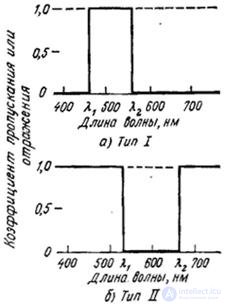Lecture
Most natural images are created by light reflected from opaque objects or transmitted through transparent media. The range of variation in the brightness of such a non-luminous object is limited and depends on its color. Mac-Adam [23, 24] proved that the color body of maximum volume is realized in the case when objects have reflection or transmission coefficients shown in Fig. 3.7.3. Such objects do not physically exist; therefore, the color body of real objects has a smaller volume. We explain this by limiting for simplicity only the case of objects reflecting light. The same reasoning will remain fair in the case of transparent objects.
Consider the color  given by color coordinates
given by color coordinates
 (3.7.3a)
(3.7.3a)
 , (3.7.3b)
, (3.7.3b)
 , (3.7.3в)
, (3.7.3в)
Where  - spectral reflection coefficient,
- spectral reflection coefficient,  - the spectral density of the radiation of light falling on the object,
- the spectral density of the radiation of light falling on the object,  - addition function. Visual efficiency
- addition function. Visual efficiency  defined as the ratio of the brightness of the object with the reflection coefficient
defined as the ratio of the brightness of the object with the reflection coefficient  to the brightness of the object with a unitary reflection coefficient, i.e.
to the brightness of the object with a unitary reflection coefficient, i.e.
 (3.7.4)
(3.7.4)
If the object has a reflection coefficient of the type shown in Fig. 3.7.3, and, its brightness is equal
 (3.7.5)
(3.7.5)

Fig. 3.7.3. Optimal spectral coefficients of reflection or transmission of non-luminous objects.
Suppose the spectral density is known  energy of incident light. Then you can calculate the brightness of the subject, if you know the value of visual efficiency
energy of incident light. Then you can calculate the brightness of the subject, if you know the value of visual efficiency  . For a given minimum wavelength
. For a given minimum wavelength  maximum value
maximum value  can be found numerically from the equation
can be found numerically from the equation
 (3.7.6)
(3.7.6)
Using the found value  can calculate color coordinates
can calculate color coordinates  :
:
 (3.7.7)
(3.7.7)
 (3.7.8)
(3.7.8)
Chromaticity coordinates  and
and  can be found by color coordinates. If this procedure is repeated for all possible values
can be found by color coordinates. If this procedure is repeated for all possible values  for given values of visual efficiency
for given values of visual efficiency  , it is possible to obtain a surface that bounds the body of possible colors of objects, in color coordinates or color and brightness coordinates. In fig. 3.7.4 shows such a surface in terms of chromaticity and brightness when illuminating objects with a source of white light. Note that the maximum brightness corresponds to the white surface.
, it is possible to obtain a surface that bounds the body of possible colors of objects, in color coordinates or color and brightness coordinates. In fig. 3.7.4 shows such a surface in terms of chromaticity and brightness when illuminating objects with a source of white light. Note that the maximum brightness corresponds to the white surface.

Fig. 3.7.4. Color body of objects in chromaticity and brightness coordinates  [23].
[23].
Comments
To leave a comment
Digital image processing
Terms: Digital image processing